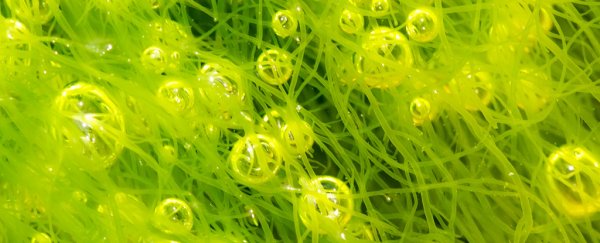Life has been soaking up sunlight and storing it as a fuel source for billions of years. But scientists have just put a new twist on this ancient process that could finally provide us with the efficiency we need to compete with fossil fuels.
A study led by the University of Cambridge in the UK has resulted in a better way to split water into hydrogen and oxygen by linking a photosynthesis pathway with an enzyme called hydrogenase.
While there's nothing new about breaking water apart to create a clean supply of energy, most methods to date have relied on expensive catalysts, making it a challenge to go economy-size.
This new process could change that.
Photosynthesis is the rearrangement of water and carbon dioxide into glucose, locking up light energy for later use while releasing free oxygen.
It's done a good job keeping plants, algae, and certain bacteria alive for a few billion years, and is ultimately responsible for making the fossil fuels we now burn by the tonne.
But it's not overly efficient as far as energy capture processes go. After all, plants only need a few percent of the energy that rains down from the sky each day.
And freeing that energy now stored as coal comes with the problem of also freeing all that carbon dioxide, which, as we know has unleashed its own problems.
Scientists have now invented a semi-artificial version of photosynthesis that improves on nature's formula, reactivating a long-abandoned process that evolution had left behind.
They key is an ancient enzyme known as hydrogenase.
"Hydrogenase is an enzyme present in algae that is capable of reducing protons into hydrogen," says chemist and lead author, Katarzyna Sokół.
"During evolution this process has been deactivated because it wasn't necessary for survival but we successfully managed to bypass the inactivity to achieve the reaction we wanted – splitting water into hydrogen and oxygen."
Mimicking photosynthesis in the name of collecting and storing energy is something scientists have been experimenting with for years. More than just a potential power source, it could also help mop up carbon dioxide in its traditional form.
But according to Sokół, most earlier technologies simply won't scale up to industrial levels, either because they're too expensive, inefficient, or use materials that pose their own risks as pollutants.
Her team's approach was to create an electrochemical cell – not unlike a battery – based on the light-collecting biochemistry of a process called photosystem II.
This provided the necessary voltage required for the hydrogenase enzyme to do its work, reducing the hydrogen in water so it can divorce from oxygen and bubble away as a gas.
It sounds simple in principle, but connecting artificial systems with organic processes is anything but a walk in the park.
"This work overcomes many difficult challenges associated with the integration of biological and organic components into inorganic materials for the assembly of semi-artificial devices and opens up a toolbox for developing future systems for solar energy conversion," says author and laboratory head, Erwin Reisner.
This process is unlikely to be the end point, with plenty more research to be done. Finding the right balance of natural materials and human intervention could be the ticket to inexpensive, truly clean solar energy.
"This could be a great platform for developing solar technologies," says Sokół.
"The approach could be used to couple other reactions together to see what can be done, learn from these reactions and then build synthetic, more robust pieces of solar energy technology."
A hydrogen fuel economy is still some way off in the future, with other challenges to overcome in storage and transport. Though researchers are making plenty of headway there as well.
With our dependence on fossil fuels continuing to drive a global climate crisis, cheap, safe alternatives can't come soon enough.
This research was published in Nature Energy.
